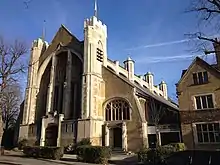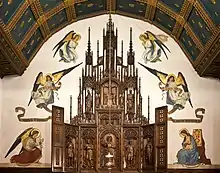St Peter's Church, Ealing
St Peter's Church, Ealing, is an Anglican parish church in Mount Park Road, North Ealing, in the Diocese of London, regarded by John Betjeman as being amongst "the noblest churches we possess".[1] Held to be one of the premier architectural works in Ealing, the Grade II* Listed building is noted for its combination of Arts & Crafts and late-Victorian Gothic as well as its west front and great west window.[2] In addition to Sunday and weekday services, the church and adjacent hall serve as a hub for various community activities and events.[3]



Heritage
“Notable for its unusual fusion of free Gothic style used in a highly original manner, St Peter’s occupies no small place in the last great age of church building” – Sir Roy Strong.[4]
St Peter's was built as mission church of Christ the Saviour, Church Ealing. The Rector of Christ the Saviour raised funds for four daughter churches; St John's Church, Ealing, St Stephen's Church, Ealing, St Saviour's Church, Ealing, and St Peter's.[5]
The land on for the church was donated by John Clark Record.[6] Replacing an iron church which had stood on the site for 10 years, St Peter's was built between 1892 and 1893 to accommodate the growing suburb of North Ealing. The original iron church had been dedicated to St Andrew and it was originally proposed to give the same name to the new church. However, when the Presbyterians started to build in Mount Park Road in 1889, the vestry felt that "this Church should set the example of giving way in face of a threatened dispute about the Saint's name' and with commendable tact abandoned the 'Scottish' saint in favour of St Peter."[7]
The new building was designed by John Dando Sedding, the architect of Holy Trinity, Sloane Street, but following Sedding's death it was built under the direction of his pupil and successor in practice, the noted designer and architect Henry Wilson. The foundation stone was laid in 1893 by Princess Helena, Queen Victoria's third daughter. The building was consecrated the same year by Frederick Temple, Bishop of London and later Archbishop of Canterbury.[4] Henry Wilson created the brass pannels on the inside of the main doors, worked with flowing pattens. This decoration was accompanied by the bronze figure of an angel by F. W. Pomeroy, a feature which is now lost.[8]
Sedding's plans for the church were complimented by The Builder magazine as "a piece of real originality in design, which is refreshing to come across after seeing so many repetitions of old forms, Classic and Gothic ". Pevsner notes the "admirable use of Gothic forms – especially the curvaceous forms of late Gothic – to produce a building of great originality".[2]
The church was added to extensively throughout the first quarter of the 20th century. In 1911, two doorways were created at the west end of each aisle, and in 1913 the Lady Chapel was built on the south side of the chancel. The north transept tower intended by Sedding was never built.[4]
A notable feature of the building, the west front, has two small turrets on either side of large the recessed west window, which is unusually large with fine composite tracery. The exterior of the building is also of note on account of the long steep nave roof with shallow chains of arches connecting small turrets.[2]
Inside, much of the intended ornamentation was never completed. However, the building's substantial four-bay nave with Gothic triforium,[9] allied with the clear glass of the windows and the lack of ornamentation, make the church unusually light and spacious.[4] Singular features include the in 1913, and the inner west doors, with decorative Art Nouveau metalwork by Henry Wilson.[4] The font was designed by Leonard Shuffrey, the architect and architectural designer, who was a member of St Peter's PCC. It was executed by Messers Blackler of Torquay and dedicated in 1911. Shuffrey also designed a portable altar for the Church[4]
Between 1921 and 1928 the Lady Chapel, originally constructed in 1913, was decorated and furnished as a War Memorial Chapel. Led by a War Memorial Committee, the scheme included the installation of an oak reredos by Leonard Shuffrey executed by Cecil Greenwood Hare, the decoration of the ceiling and a new screen between the Chapel and main Church. New altar rails were given in memory of Second Lieutenant Wilfred Holmes, son of Basil Holmes, a local politician and Isabella Holmes. The scheme also included the fine wall paintings of angels and the Virgin Mary over the reredos in the Lady Chapel, executed by Henry Charles Brewer in 1928.
Despite a scheme of stained glass being designed for the whole church, only the four lights in the Lady Chapel (showing scenes from the Nativity) and two windows in the north aisle were ever completed. The existing stained glass was designed by Walter Towers of Kempe and Co.[4]
In the south aisle is a painting by Edward Arthur Fellowes Prynne depicting Christ before Pilate. Prynne was the brother the architect George Fellowes Prynne and lived in the parish. The picture was given to the church by Prynne's widow following his death in 1921.[4]
A campaign between 2011 and 2017 to restore the west window, and the high-level stonework on the north and south sides of the church raised almost £1 million to carry out the necessary repair. This work was enabled through the assistance of English Heritage, the Heritage Lottery Fund, the National Churches Trust and others.[10]
Community
St Peter's holds services on Sunday mornings and throughout the week in addition to major services at Easter and Christmas.[3] It runs a local walking group, hosts the Ealing Churches Winter Night Shelter[11] and an organ recital series. St Peter's also holds an Amnesty letter writing group, book club, junior church and Sunday choir.[3] The church is also used by local schools for concerts and carol services.[3]
Clergy
Vicars[4]
1894 - 1909: William Petty
1909 - 1916: Henry Austin Thompson. Thompson later became Vicar of St Peter's Eton Square, where he was killed by enemy action in 1941.
1916 - 1939: Joseph Bertram Kite. Kite was formerly Dean of St David's Cathedral, Hobart, in Tasmania from 1897 to 1916.
1939 - 1946: Frank Challoner Pond
1946 - 1953: George Maurice Bosworth
1953 - 1963: Henry Cooper
1963 - 1971: Derek Tyrie
1972 - 1974: John David Wheeler
1974 - 1981: Charles Gilbert Francis Dare
1982 - 1991: Richard Hayes
1991 - 2000: William Taylor. Taylor was later Dean of Portsmouth Cathedral and is now Vicar of St John's Notting Hill.
2000 - 2011: Mark Powell. Powell is currently Canon Steward of St George's Chapel, Windsor Castle.
2012–present: David Neno
Other notable former clergy
Morris Maddocks was a curate of the church in the 1950s and was later Assistant Bishop of Bath and Wells. While at St Peter's he married Anne Maddocks, Assistant Organist of Chichester Cathedral.
Michael Tavinor, Dean of Hereford Cathedral until 2021, was a curate at St Peter's between 1982 and 1985.[12]
Connections
- Kenneth Allsop, British broadcaster, author and naturalist, was married at St Peter's in March 1942.[13]
- The funeral of Henry Austin Dobson, poet and essayist, was held at St Peter's on 6 September 1921.[14]
- General Sir Anthony Farrar-Hockley, distinguished British soldier and military historian, was married in St Peter's on 7 July 1945.[15]
- Emmanuel Phillips Fox, Australian artist, married Ethel Carrick at St Peter's on 9 May 1905.[16]
- Harry George Hawker, Australian aviation pioneer, married Muriel Alice Peaty at St Peter's on 14 November 1917.
- Basil Holmes, a local politician, was the father of Wilfred Holmes, in whose memory the Lady Chapel altar rails were donated in 1921.
- Isabella Holmes, wife of Basil Holmes, was an authority on London's graveyards, and author of 'The London Burial Grounds'. She was daughter of British Chemist John Hall Gladstone and half sister of Margaret Ethel MacDonald, wife of Prime Minister Ramsay Macdonald.,[17]
- Stephen Holmes was the Son of Basil and Isabella Holmes. He was appointed High Commissioner to Australia for the United Kingdom between 1952 and 1956.[17]
- Leonard Shuffrey (1872-1926), Architect & Architectural Designer attended St Peter's. His brother James Allen Shuffrey was a notable watercolour artist. Shuffrey's son, Gilbert Shuffrey, was killed at the Battle of Gallipoli and is memorialised on the Church's Great War Roll of Honour.[18] In 1896 a visit was paid to the newly-completed St Peter's by the members of the Architectural Association, who afterwards received tea at Thorncote, Shuffrey's new House in Ealing.[8]
- Paul Shuffrey son of Leonard Shuffrey's attended St Peter's as a child. He became Editor of the Guardian and the Church Quarterly Review.[19]
References
- Gardner, K. Betjeman on Faith: An anthology of his religious prose, SPCK, 2011.
- Cherry, B. and Pevsner, N. The Buildings of England London 3: North West, Yale, 2002.
- "St Peter Ealing - A Church Near You". www.achurchnearyou.com.
- Hayes, R. New & Old: A History of St Peter's Mount Park Road, Ealing, St Peter's Church, Ealing 1985.
- McEwan, Kate (1984). Ealing Walkabout: Journeys Into the History of a London Borough (Second ed.). p. 67. ISBN 0950889504.
- Ealing and Brentford: Churches, Ealing. London: British History Online. 1982. Retrieved 22 January 2022.
- Weinreb, Ben, and Hibbert, Christopher (1992). The London Encyclopaedia (reprint ed.). Macmillan. p. 784.
{{cite book}}: CS1 maint: uses authors parameter (link) - "THE ARCHITECTURAL ASSOCIATION SPRING VISITS : ST. PETER'S CHURCH, EALING,". The Builder. 68 (2722): 259. Spring 1895. Retrieved 2 January 2022.
- Jackson, E. 'Annals of Ealing', Phillimore & Co, 1898
- "St Peter's Church in Ealing celebrates its full restoration | National Churches Trust". www.nationalchurchestrust.org.
- "ECWNS | Our Church Venues".
- Michael Tavinor
- Andresen, M. Field of Vision: The broadcast life of Kenneth Allsop', Trafford Publishing, 2004
- Henry Austin Dobson
- Goldman, L. (ed.) Oxford Dictionary of National Biography 2005-2008, Oxford, 2013
- E. Phillips Fox
- "Search Results for Holmes, Sir Stephen, (5 July 1896–20 April 1980)". WHO'S WHO & WHO WAS WHO.
- Foster White, J (1970). The Queen of the Suburbs, John Foster White p. 6.
- "Shuffrey, Paul". Who's Who (UK). Retrieved 29 March 2021.
